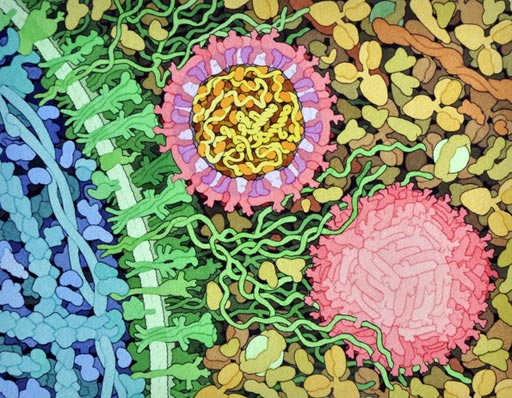New Zika Serotypes Likely to Emerge in Future
By LabMedica International staff writers
Posted on 24 Oct 2017
A Brazilian researcher warns that Zika virus is mutating so fast in Brazilian patients that different serotypes could soon appear. This would hinder the production of a vaccine and impair the effectiveness of the diagnostic tests already developed.Posted on 24 Oct 2017
The alarm was sounded by Edison Luiz Durigon, professor at University of São Paulo’s Biomedical Science Institute (ICB-USP; Sao Paulo, Brazil), in the opening address to the 2017 Annual Meeting of the Federation of Brazilian Societies for Experimental Biology (FeSBE; September 3-6, Campos do Jordão, São Paulo State, Brazil).

Image: A drawing of the outside of one Zika virus particle, and a cross-section through another as it interacts with a cell (Photo courtesy of David Goodsell).
“People become immune after being infected once, but the virus is constantly mutating, and I wouldn’t be surprised if we see Zika 2, 3, and 4 emerging before long,” Prof. Durigon told the Sao Paulo Research Foundation (FAPESP; Sao Paulo, Brazil).
This assertion was based data from 3 asymptomatic patients – 2 men and 1 woman – monitored weekly in a study conducted under the auspices of the Zika Virus Research Network in São Paulo (Rede Zika), supported by FAPESP. The researchers collected blood, saliva, and urine, as well as semen from the men. Samples were sent for whole-genome sequencing of the virus in partnership with the US Army.
“Week by week, we examined the data to see what was different in the viral genome,” said Prof. Durigon, “In one patient, we found compartmentalized strains: the virus present in his semen was different from the virus in his urine. In all cases, the pathogen we found in the final stage of the infection wasn’t the same as the virus that entered the patient.” Both male patients continued to excrete large amounts of Zika virus in their semen for up to 6 months; one had Zika in his saliva for 3 months.
“Using an electron microscope, we could see that the spermatozoa were formed already infected,” he said, “This means a conception could occur with infected sperm. We have no idea whether pregnancy progresses in such cases, and if so, what the consequences would be for the fetus.” “It’s no use testing only pregnant women to see if the virus is present,” he said, “while leaving men to go on with their lives as normal.”
According to Durigon, the scientific community’s swift response in São Paulo inspired other groups and funding agencies in Brazil, enabling the creation of a nationwide Zika network. Advances achieved include validation of a serological test that can be used also after the infectious stage is over. Validation included 800 samples from patients in Salvador, Bahia. “If this test can identify Zika in Salvador, it can work anywhere in the world,” he said, “Bahia, Pernambuco, and Paraíba will probably have few cases for at least 4 years or so, until a significant proportion of the population is susceptible again. In São Paulo, we don’t yet know.”
Up to 80% of cases may be asymptomatic, so without the serological test it is impossible to know the real magnitude of the epidemic and percentage of the population that is still susceptible. The team that developed the serological assay also includes ICB-USP researchers Paolo Zanotto and Luís Carlos de Souza Ferreira.
A main concern today is children who “may have brain damage but not microcephaly, so they won’t be carefully monitored. The problem won’t appear until later, when they start displaying motor or learning difficulties. We could have a generation of children with all kinds of complications.” All children born during the period should be tested. Positive results should be assessed with caution and confirmed by imaging.
Related Links:
University of São Paulo’s Biomedical Science Institute
Sao Paulo Research Foundation













